Using BusyCal with iCloud
iCloud is Apple's free online service, which includes calendar syncing among its many features. BusyCal can connect to iCloud Calendar directly for syncing calendars across your devices and sharing them with others.
For details on using BusyCal with iCloud, see the following:
- Syncing with iCloud
- Sharing Calendars with Others through iCloud
- Hosting Calendars on iCloud
- iCloud Limitations
Syncing with iCloud
Apple requires all third-party apps to connect to iCloud using a special app-specific password, which protects your real password. Before adding your iCloud account to BusyCal, you must first generate an app-specific password (explained below). This extra step ensures security while allowing BusyCal to sync with your iCloud data. Learn how to generate an app-specific password.
BusyCal can use iCloud to sync calendar data across all your devices.
To sync BusyCal with iCloud, do the following:
- First and foremost, navigate to https://support.apple.com/HT204397 using your browser and follow instructions on generating an app-specific password for your iCloud account (see demo video below). If you have already performed this step for some other app in the past or for another device running BusyCal, you may re-use the same password on this device. App-specific passwords can be re-used multiple times in several apps, if desired. After you have generated an app-specific password, save it some place secure in order to re-use it on another device running BusyCal. When unsure, generate a new one and copy / paste it somewhere secure.
Over the years we've gathered some best practices:
- If you have a
@mac.comemail address, replace it with a@icloud.cominstead when using with BusyCal - iCloud allows one to generate aliases for their primary iCloud email addresses. When using it with BusyCal, you must only use your primary iCloud email address to login, aliases do not work.
- Your device must be configured to Set time and date automatically under System Settings > General > Date & Time otherwise the password will superficially fail to work without an obvious reason.
- Next, open BusyCal Menu > Settings > Accounts
- Click the
+(plus) icon, near the bottom left corner of the settings dialog, to add a new account. - Choose iCloud from the Server Type pop-up menu, then enter your Apple ID / iCloud Email Address.
- Enter the app-specific password generated in
step 1above and click OK.
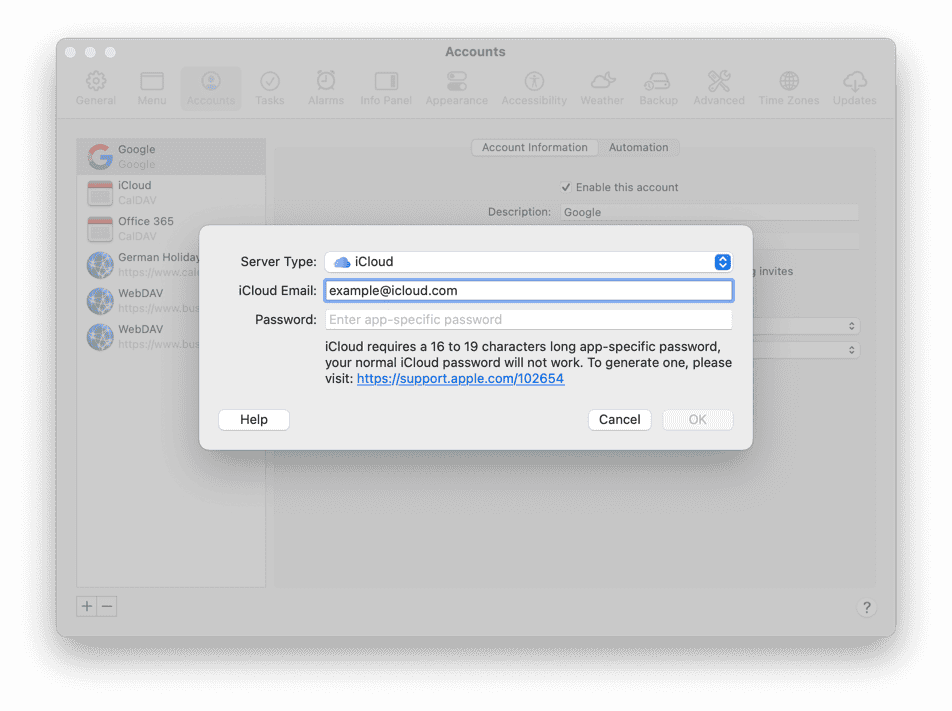
Generating App-Specific Password
The following video demonstrates how to generate and use an app-specific password for iCloud.
- Log into your iCloud account: https://account.apple.com/
- Generate an app specific password
- Copy the password and use in BusyCal iOS. Preferably, save this password securely for future use.
On iCloud, Meeting Invitations that you received from others will automatically get added to your preferred Meeting Calendar. You can change this setting under BusyCal Setting > Accounts > iCloud Account > Meeting Calendar.
Sharing Calendars with Others through iCloud
Please log into your account on www.icloud.com and setup sharing of calendars there. BusyCal will then pull these changes during the next sync.
Once each user has configured BusyCal to sync with their personal iCloud account, your shared calendars will be accessible to you like any other calendar, provided these have been setup on www.icloud.com.
Shared Calendar Messages
When using shared calendars, there are two options you may want to enable, for keeping track of changes to events on shared calendars:
-
First, in BusyCal > Settings > Advanced > Other, select Confirm changes to events on shared calendars if you want to display a warning when you edit or delete an event on a shared calendar.
-
Second, in the Calendar Info dialog for any given calendar (which you can display by double-clicking the calendar name in the calendar side panel), select Show change notifications in Inbox to display a badge on the app icon and a message in the Inbox when events are added or changed by others, or deselect it to avoid seeing badges and Inbox notifications for that calendar.
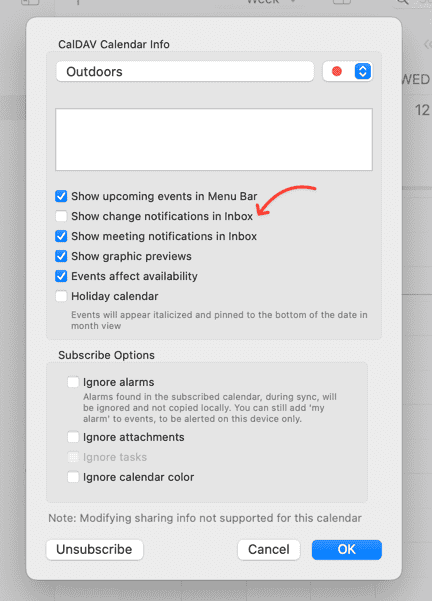
- Open BusyCal > Settings > General and select Inbox Notifications under Dock badge count, if desired.
Hosting Calendars on iCloud
How iCloud Syncing Works
iCloud functions as a CalDAV server that syncs with client apps.
BusyCal (for both macOS and iOS) and the built-in Calendar app on macOS and iOS are CalDAV clients that sync with iCloud.
This means any data you enter into the built-in Calendar app on macOS or iOS will sync to BusyCal through iCloud, and vice versa. As long as you have all client apps configured to sync with the same iCloud account, all your calendar data remain in sync.
Calendars Must Be Hosted on iCloud
All calendars you want to sync between your Macs, iOS devices, and other users must be hosted on iCloud. You cannot sync calendars from other sources (On My Mac, Google, Exchange, etc.) to iCloud.
If you have any existing calendars hosted elsewhere that you want to host on iCloud, you can move them to iCloud or merge them with an existing calendar in iCloud, as follows.
Move a Calendar to iCloud
For this example, let’s say you have a local calendar called “Work” that you want to host on iCloud. Here’s how you can move it to iCloud:
- Make sure you are syncing with iCloud and that your iCloud Account appears in the left sidebar.
- Control-click the calendar that you want to move to iCloud and choose Move to iCloud from the contextual menu.
- iCloud requires you to store events and tasks on separate calendars. If the Work calendar contains both events and tasks, it will be transformed into two calendars on iCloud—one for events and one for tasks. The Task calendar will be indicated with a checkmark next to its name, as demonstrated below for a task calendar named DIY.
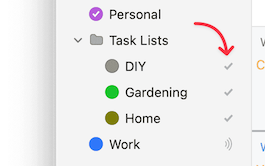
Merge with a Calendar on iCloud
For this example, let’s say you have a local calendar called “Work” that you want to merge with an existing calendar on iCloud called Company. Here’s how to do it:
- Export the Work calendar by selecting it in the left sidebar and choosing File menu > Export > Calendar File (.ics), and save it to your desktop. Then delete the Work calendar from BusyCal by control-clicking on it and choosing Delete from the contextual menu.
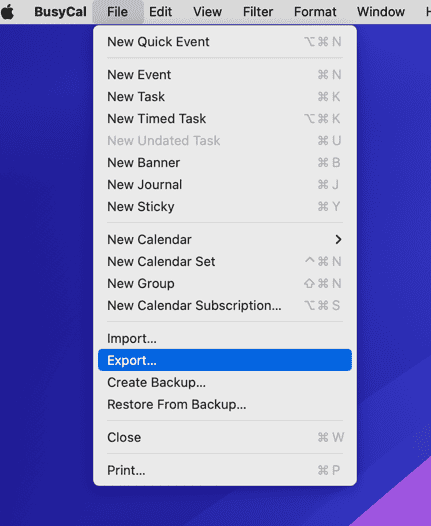
- Choose File menu > Import and select the file you exported in
step 1. If the Import events into section does not appear at the bottom of the dialog, click Options to display it. Select Existing Calendar, and choose the Company calendar (which is hosted on iCloud). BusyCal adds the events from the Work calendar to the Company calendar on iCloud.
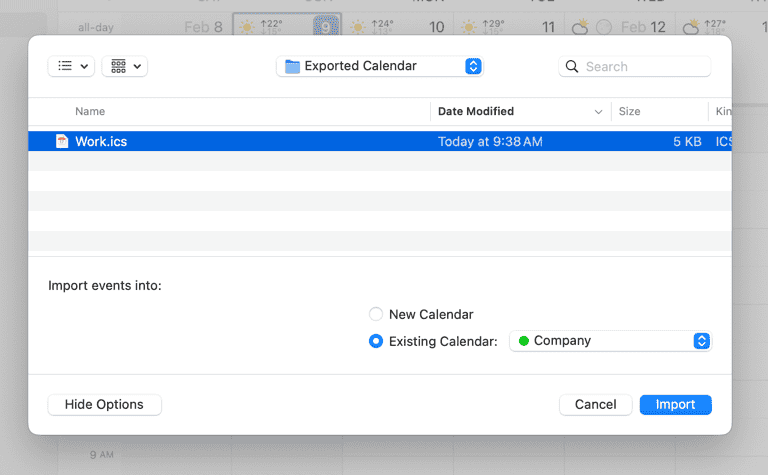
iCloud stores events and tasks on separate calendars - in fact, iCloud has now migrated and moved tasks to the new Reminders app which is no longer directly connected to iCloud Calendar. Therefore, if you attempt to import a calendar that contains both events and tasks into a calendar on iCloud that only supports events, the tasks will be rejected. To import the tasks, you must repeat this step and import into an existing calendar on iCloud or Reminders that supports tasks.
After merging the calendars, you can remove duplicate events by choosing Help > Find Duplicates.
Why Doesn’t BusyCal Sync Directly with Apple Calendar?
BusyCal offers direct iCloud syncing via the open CalDAV protocol, allowing full access to all features. While it also supports connecting to Apple Calendar without needing to connect to iCloud, this method comes with significant limitations.
Apple Calendar restricts third-party apps from accessing many advanced scheduling features when syncing this way, leading to a reduced experience. We've outlined these limitations in more detail here.
Why is Push Sync Not Supported?
The Push Sync option in BusyCal Settings > Accounts > iCloud > Refresh Calendars is intentionally disabled because iCloud does not allow third-party apps to subscribe to push updates. Instead, you can select a periodic sync interval, such as Every 5 minutes.
That said, BusyCal intelligently syncs in the background at various times to keep your calendar up to date. The lack of a push sync option should not impact your overall experience.
iCloud Limitations
iCloud places certain limits on calendar data.
Quota Limitations
Irrespective of how much you're paying iCloud for online storage, iCloud places fixed limits on the amount of data that can be stored within the Calendar app. For instance, you may have a 2 TB storage option but will still have the following limits applied. These limits also apply to the built-in Apple Calendar app:
-
Total number of calendars, events, and reminders: 50,000*
-
Maximum combined number of calendars and reminder lists you can have: 100*
-
Maximum size of all calendar and reminder data (not including attachments): 1GB*
-
Maximum number of characters in a reminder title: 1,000*
-
Maximum size of a calendar event including attachments: 20MB
-
Maximum number of attachments per event: 20
-
Maximum number of attendees you can invite to an event: 300
-
Maximum number of people with whom you can share a private calendar: 100
-
If you have upgraded your iCloud reminders on a device running iOS 13, iPadOS, or macOS Catalina or later, these limits on reminders do not apply. Learn more about the Reminders upgrade process.
For more information, see iCloud: Limits for Contacts, Calendars and Reminders.
Solution
One thing that could help is to archive old events. We have instructions on how to archive old events here.
Calendar Limitations
BusyCal syncs all its data types (events, to dos, journals, graphics, stickies, attachments, tags, etc.) with iCloud.
If you are syncing multiple Macs running BusyCal with the same iCloud account, all these data types should sync seamlessly. However, there are some limitations to be aware of when syncing these data types with other apps (such as Calendar for macOS or iOS) through iCloud:
- Stickies, Journals, and Graphics in BusyCal sync between BusyCal clients through iCloud, but appear as all-day events in Calendar and other clients.
- Tags applied to events in BusyCal sync with other copies of BusyCal through iCloud, but do not appear in Calendar or other clients.
- Tasks in BusyCal sync with the Reminders app on macOS and iOS through iCloud. They do not appear in Calendar for macOS or iOS.
⚠️ Troubleshooting
If iCloud fails to connect or displays cryptic error codes like -1012, it may be due to an incorrect or expired app-specific password.
This can happen for various reasons, especially if you recently reset your main iCloud password—doing so automatically revokes all existing app-specific passwords.
cannot log into iCloud, iCloud password. iCloud fails. iCloud login failure. iCloud password prompting. Can't login to iCloud. Cannot login. icloud error, icloud password, icloud app specific password, appspecific password Cannot sync with iCloud. Can't sync iCloud. iCloud won't sync. iCloud stopped syncing. iCloud password invalid. Password not working. iCloud password request. Forgot password. Forgotten iCloud. Lost password. Change password. old password not working. Old password failed. Login fails. Login failed. Password fails. Password not accepting. Password not working. Account not working. password keeps popping up. Password keeps prompting. Keeps prompting for password. Password prompt keeps popping showing up.
The most reliable solution is to remove your iCloud account from BusyCal and set it up again by following these steps. Please check tips under the Best Practices section as it could be due to one of the things mentioned in that section.
To remove and re-add your account:
- Open BusyCal Settings > Accounts.
- Select your iCloud account and click
[-]to delete it. - Click
[+]to add a new account and follow these steps.
🛠️ Duplicate Tasks Appearing
Apple migrated tasks from iCloud Calendars to the dedicated Reminders app as part of an upgrade, explained here. This upgrade is triggered when launching the Reminders app and tapping the Upgrade button.
If you did not complete the upgrade, your task lists may appear in two places:
- Reminders app
- iCloud CalDAV server
Since both still reside on iCloud, adding both Reminders and your iCloud account to BusyCal will result in duplicate tasks, as BusyCal will fetch the same data from both sources.
To remove duplicates, follow these steps:
- Open BusyCal Settings > Accounts.
- Select Reminders from the list.
- Click the
[-]button to delete the Reminders account.
This ensures that tasks sync only from your iCloud account, preventing duplicates.